Mantis Review
40 mph
Speed
30 miles
Range
61 lbs
Weight
The Mantis Base is quick, affordable, and fashioned with the same best-in-class suspension system as its bigger brothers, the Mantis Pro and Pro SE. More importantly, it’s a fantastic gateway into the world of performance scooters. As a scaled-back version of the Mantis Pro, you can be forgiven for confusing the two – but don’t let your eyes deceive you. While the Base doesn’t boast all the bells and whistles of its doppelganger, it weighs less, can go just as fast, and is a whole $650 cheaper – meaning it’s a scooter that any self-respecting bargain hunter will find impossible to ignore.
$1,699.00 $1,649.00
*Offers displayed are from retailers that we trust. If only one offer is available this is because they are the only retailer we recommend. To support our rigorous scooter review and editorial process, we rely on affiliate commissions. These are at no cost to you. Our work is independent and impartial. Read more here.
Kaabo Mantis Review: 11 Things You Need to Know
Video Review & Comparison of Manti Models
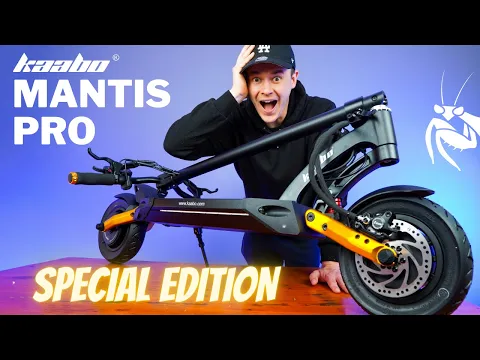
What makes the Mantis Pro SE Special? Which is Better – the Mantis Base, Pro, or Pro SE?
From its bright blue deck lights to the EY3 Minimotors display, gold trim, and powerful dual 60V 1000W motors, the Mantis Pro SE confidently makes it into my list of favourite scooters. There are several reasons why the Pro SE stand out from the rest of the Manti lineup. Watch the video to see what makes it special.
Who is it Best For?
Will the Mantis Be a Good Fit For You?
The Mantis Base is a great fit for riders who want to get their hands on a lot of pace, but for less cash. It’ll suit those looking for their second or third scooter; who want to take the step up from a commuter scooter, but, equally, don’t want to spend $2,000+ to get their hands on top-performing models like the VSETT 10+R.
Of course, the Base’s affordability means it will preclude you from the bigger, better features you’ll see on more premium models. It doesn’t have the most advanced or customizable display console and its battery and braking setup aren’t as effective either.
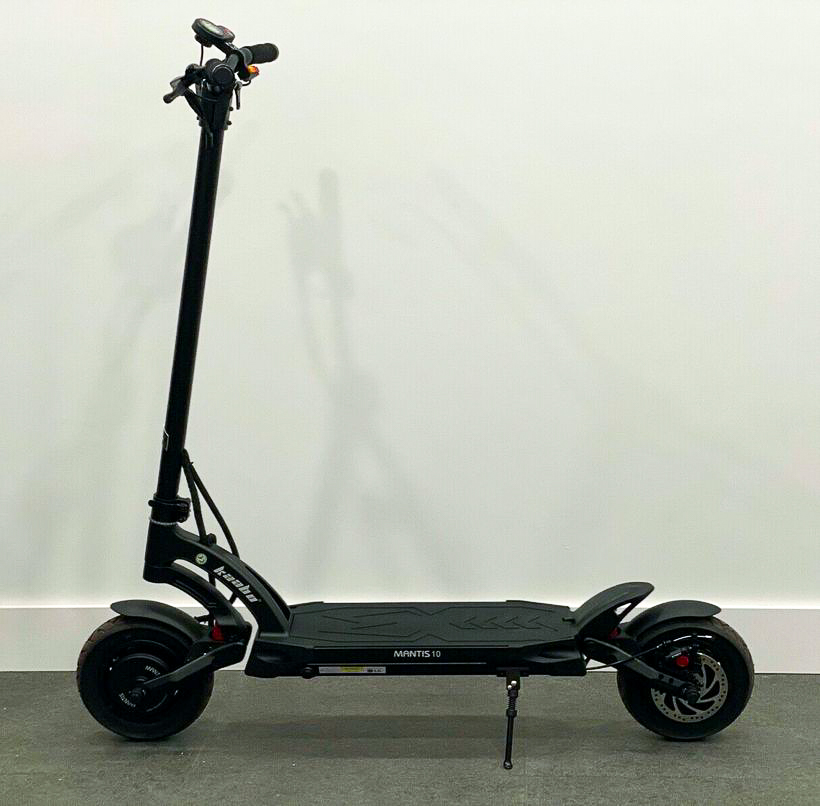
However, the Mantis Base is still capable of hitting those same 40 mph top speeds as the Mantis Pro, Pro SE (the ‘Special Edition’ version), and several Dualtron scooters, too – so it’ll suit you if you have a need for speed.
At 61 lbs, though, the Mantis Base is too heavy to be considered a commuter scooter, and I’m reluctant to recommend it to anyone new to electric scooters on account of its lightning-quick acceleration rate.
Pros and Cons
- Affordable entry into the performance scooter market
- Fast, with a quick acceleration rate and dual motors
- Good hill climbing capabilities
- Mood deck lighting adds a touch of class to the deck’s undercarriage
- Semi-hydraulic brakes provide good stopping power
- Dual spring suspension delivers a comfortable ride
- No headlight
- No horn
- The rear fender is too short, allowing mud and dirt to fly up and coat your back
- No water resistance rating
Value for Money
Is the Price Tag Worth it?
The Mantis Base is affordable with strong specs and a performance that – when compared with other scooters in its class – excels.
However, despite being one of the strongest options in its pricing bracket, the Mantis Base suffers when viewed alongside its fellow models in the Mantis range
Take a look at what I mean in the table below.
Comparison of Manti Models
| Specs | Mantis Pro SE | Mantis Pro | Mantis Base |
|---|---|---|---|
| Motors | 2 x 60V 1000W | 2 x 60V 1000W | 2 x 60V 1000W |
| Battery | 60V 18.2AH LG (24Ah available) | 60V 24.5AH LG | 60V 17.5Ah FST (Chinese cells) |
| Range | 30-40 miles | 45-55 miles | 30-40 miles |
| Brakes | Zoom Full Hydraulics | Zoom Full Hydraulics | Semi-Hydraulics |
| Display | Minimotors EY3 | Minimotors EY3 | QS-S4 |
| Motor Buttons | Improved Design | Yellow/Red | Yellow/Red |
| Deck Lights | Blue | White | White |
| Price | $1,899 | $2,299 | $1,649 |
As you can see, the Mantis Pro SE is available for an extra outlay of just $250 more than the Base. Yet, the improvements that the SE makes over the Base are comprehensive, and include:
- An upgraded MiniMotors EY3 display, in contrast to the Base’s QS-S4 screen.
- Fully hydraulic brakes, as opposed to the semi-hydraulic setup the Base totes.
- A better design, with gold swingarms and handlebar accents, plus an alluring strip of blue LED mood deck lights.
- Replacing the slightly garish, and old, yellow and red motor selection buttons with a black, more understated (and waterproof) pair.
- An extra 10 miles of range.
- A bigger battery, with superior LG cells that ensure consistent performance without deterioration for hundreds of charge cycles.
- Improved build quality through a reinforced stem and stronger stem bolt to eliminate stem wobble and make the Pro SE more durable when ridden off-road. Plus, increased motor depth alongside longer bolts to prevent shearing.
With all of this in mind, and while the Mantis Base gets voted as one of the best scooters by the community, it’s good to look past the hype and dig deep into the overall package compared to other scooters. From this perspective, I guess what I’m trying to say is that the Base isn’t bad value – it’s just not as good bang for your buck as the Pro SE is.
For more info about the Mantis Pro SE and how it compares to the Base and original Pro, check out my full review. Likewise, you can check out my review of the Mantis Pro.
Alternatives
What Other Scooters Should You Consider?
Mantis Pro SE
- Speed: 40 mph
- Range: 40 miles
- Weight: 65 lbs
- Load: 330 lbs
Why is it Better Than the Mantis Base?
- 20% faster acceleration rate
- More range (+10 miles)
- Superior battery with LG cells vs the cheaper Chinese variety
- Supports more rider weight (+65 lbs)
- Better brakes (Zoom fully hydraulic, rather than semi-hydraulic)
- Upgraded MiniMotors EY3 display
- Improves on the cheap yellow/red design of the Eco/Turbo and single/dual motor buttons
- Better design with striking red and gold accents, and blue LEDs replacing the Base’s white mood deck lighting
Why is it Worse Than the Mantis Base?
- Costs more (+$250)
- Heavier (+4 lbs)
Price:
- 1,899.00
- Discount Code: Get $50 Off
Mantis Pro
- Speed: 40 mph
- Range: 45 miles
- Weight: 65 lbs
- Load: 265 lbs
Why is it Better Than the Mantis Base?
- 20% faster acceleration rate
- Longer range (+15 miles)
- Superior battery with LG cells vs the cheaper Chinese variety
- Better brakes (Zoom fully hydraulic, rather than semi-hydraulic)
- Upgraded MiniMotors EY3 display
Why is it Worse Than the Mantis Base?
- Costs more (+$650)
- Heavier (+4 lbs)
Price:
-
2,299.00
$2,499.00 - Discount Code: Get $100 Off
Apollo Ghost
- Speed: 34 mph
- Range: 39 miles
- Weight: 64 lbs
- Load: 300 lbs
Why is it Better Than the Mantis Base?
- Cheaper (Save $150)
- Better range (+9 miles)
- Superior battery with Dynavolt cells vs the cheaper Chinese variety
- Supports more rider weight (+35 lbs)
- Has foldable handlebars for enhanced portability
- IP54 water-resistance rating
Why is it Worse Than the Mantis Base?
- Slower (-6 mph)
- Inferior brakes (disc, rather than semi-hydraulic)
- Heavier (+3 lbs)
Price:
- 1,499.00
Design
Handlebars
The Mantis Base sports wide, comfortable handlebars that are made of the same durable aluminum alloy blend as the stem – although, with a span of 24 inches, and not being foldable, you need a good amount of space to store the scooter. On the upside, their solid build and wide profile instill confidence while riding as they allow for enhanced control over the steering column, no matter whether you’re cruising along at 15 mph or hitting the top 40 mph threshold.
Thankfully, the handlebars are also largely free of any stem wobble, thanks to the robust stem locking mechanism.
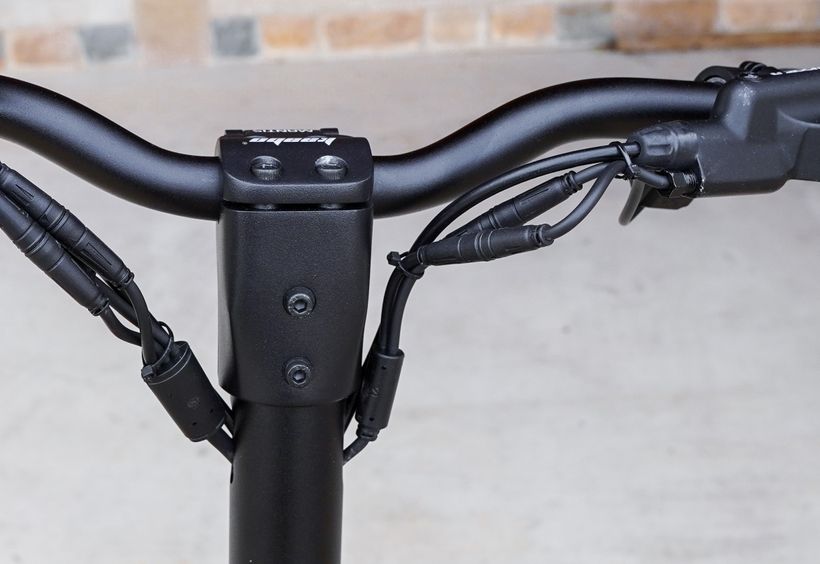
Located on the handlebars, you’ll find a range of controls, which include:
- The scooter’s QS-S4 display, for monitoring your battery life, speed, riding mode, and distance traveled – and which also serves as your finger-throttle.
- A pair of hand-operated semi-hydraulic brake levers.
Buttons for choosing how many motors you want to engage, and choosing your ride mode. - A button that turns the LED lights on and off.
If there was one thing I could change about the handlebars – and this is an issue we also see on its Manti siblings, the Pro and Pro SE – it would be the grips. Clad in foam padding, they are more prone to wear and tear and harder to clean than rubber handgrips.
Frame
Looks-wise, there’s nothing to separate the Base from the Mantis Pro.
The Base shoots straight for the hearts of most scooter enthusiasts with a simple, stripped-back matte black color scheme. Fine accents of red are used to highlight the treads of the tires and springs of the suspension.
While the design of the frame doesn’t add anything new to the aesthetics of the performance world, it won’t alienate anyone, either. The similarly-priced VSETT 9+R – a scooter that made some interesting design choices, with its vivid aquamarine color palette – may have polarized some riders, but at least it pushed the boat out.
Fortunately, if you want a little more excitement in the look and feel of your scooter, you can pay an extra $250 and bag the Mantis Pro SE. Adding an eye-catching gold hue to the swingarms and handlebars, as well as switching up the mood deck lighting from white to blue, the Pro SE makes much more of a statement than the Base and Pro.
Deck
The first thing you’re likely to notice while observing the deck is the strip of white LED mood lighting running the length of its sides. The deck also hosts sets of front and rear button lights embedded into it. While these don’t do a whole lot for its visibility, they do light up the Base’s deck from below, similar to stage lighting at a theatre.
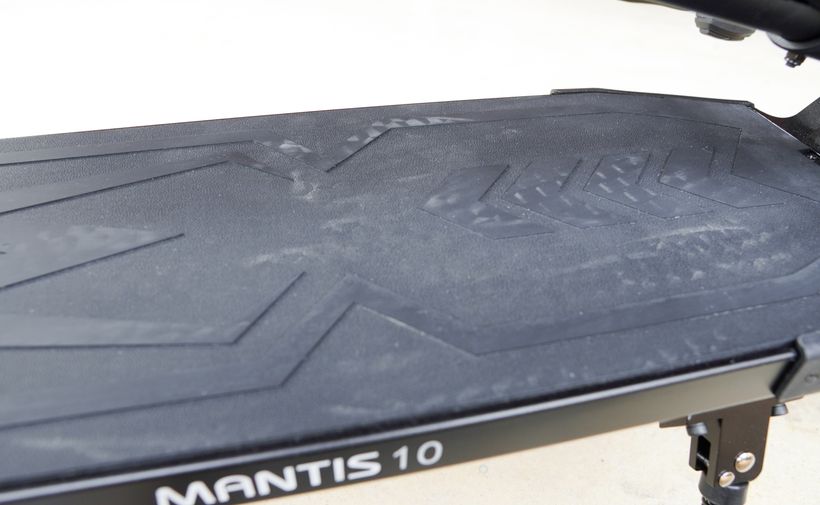
When it comes to the platform, it is covered in anti-slip rubber that is easy to clean and grippier than other scooters that use just a couple of strips of grip tape, like the EMOVE Cruiser. Interestingly, the matting can be peeled up at the edges – something we don’t see on all scooters. While this seemed like it would be a distraction while riding, it stayed firmly in place, and, as it turns out, it’s a good thing that you can peel it up. It has been designed like this to allow you to unscrew and lift the battery out for maintenance.
Another great thing about the deck is the kickplate located at the rear. This platform of reinforced metal is great for placing your back foot while riding. It helps you to maintain stability and increase traction when it comes to reaching the scooter’s top speeds and braking.
Wheels
Measuring 10 x 2.5 inches apiece, the Base is equipped with two chunky pneumatic tires. Working in cahoots with the front and rear dual swingarm suspension, these tires (which are air-filled, rather than solid) help absorb a lot of the impact from the terrain underfoot and provide you with a stable, comfortable ride.
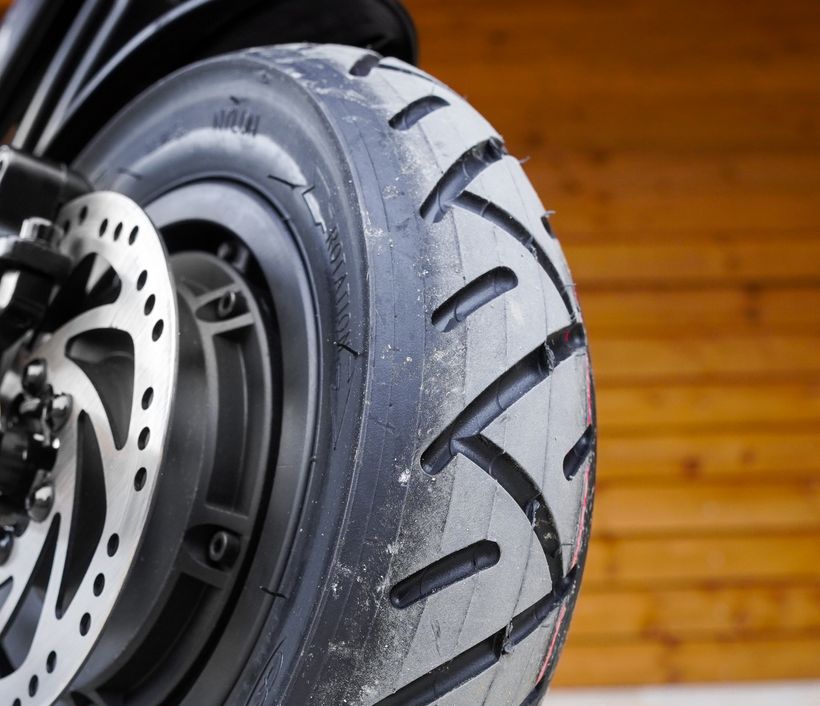
They are also what allow the Base to be comfortable when traversing forest paths and dirt trails, as well as the well-paved surfaces of the city. Possibly my only gripe is that Kaabo (the company behind the Manti line of scooters) currently doesn’t make a pair of interchangeable off-road tires for the Mantis Base. This means that it is ultimately less suited to off-roading than scooters built specifically for this purpose, or models that do offer an extra set of off-road tires, such as the Mantis Pro, or for extreme off-roading, the Wolf Warrior.
Build Quality & Durability
Kaabo has built the Base with most of the same materials that made the Wolf Warrior and Wolf King such a hit.
A hard-wearing aviation-grade aluminum alloy makes up the Base’s frame, with reinforced plastic utilized for its consumables, such as the rear fender.
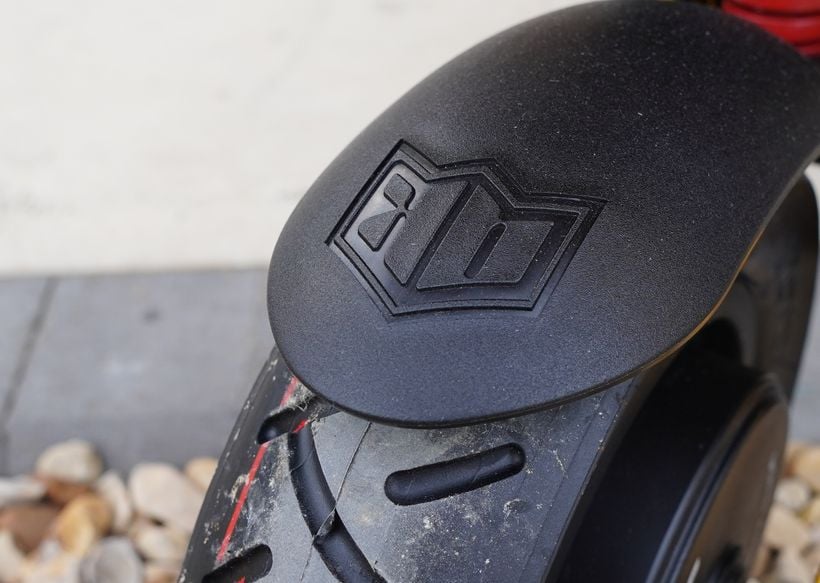
All in all, the Base is extremely durable and has been stress-tested to ensure that it’s fit for the gauntlet of everyday use. My main issue is that the Base – like the Pro and Pro SE – doesn’t flaunt any kind of water resistance rating. This sets the Base back from some similarly-priced competitors, such as the Apollo Ghost and the VSETT 9+R, both of which lay claim to IP54 ratings.
It’s also worth noting that the rear fender is a little too short. While this won’t be a problem on dry, sunny days, it will be more of an issue when you’re riding through wet and muddy surfaces. By the end of your ride, you’ll find your back covered with splatters of mud and water – so it’s worth paying attention to the conditions in which you’re riding.
Weight & Load
The Mantis Base weighs 61 lbs – a full 4 pounds less than the Pro and the Pro SE. This is about what you’d expect a scooter of the Base’s specs and features, particularly when you consider that other 40 mph scooters – such as the INOKIM OxO (74 lbs), Varla Eagle One (77 lbs), and EVOLV Pro Plus (77 lbs) – all weigh a significant amount more than the Base.
However, at 61 lbs, the Mantis Base still isn’t light by any stretch of the imagination – so it’s unlikely to fit the bill if you’re looking for a scooter to get you over that last mile of your daily commute.
Now, let’s talk about load. Capable of supporting up to 265 lbs of rider weight, the Base mirrors the load-bearing capacities of the Mantis Pro but falls short of the whopping maximum load of the Mantis Pro SE, which can support up to 330 lbs of rider bulk.
Against that backdrop, the Mantis Pro SE (available for just $250 more than the Base) is the better choice among the Manti models, particularly if you are a heavier rider. If you’re happy to look beyond the Manti range, however, the Apollo Ghost (which you can get to grips with in the ‘Alternatives’ section above) can bear up to 300 lbs of rider weight and is a great all-round performance scooter.
Folding & Portability
The Mantis Base folds in half at the base of its stem via a locking ring and pair of unique quick-release buckles. Simply loosen these to slide the locking ring upwards, and then collapse the stem down. When folded, the stem locks into its deck, making it easier to pick up and transport.
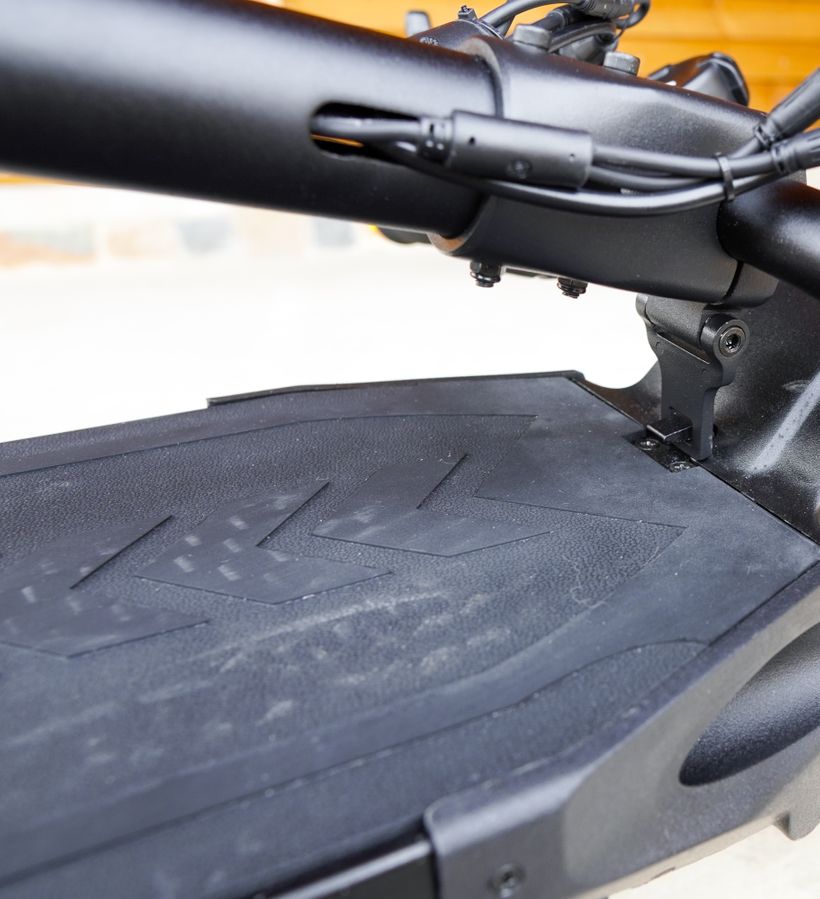
I’ve said it before, and I’ll say it again – the Mantis Base isn’t portable enough for me to consider it a commuter scooter. While its stem folding mechanism is nimble, secure, and super intuitive, the handlebars don’t fold, and – with a weight of 61 lbs – it’s too heavy to serve as an accompaniment on trains, buses, or as part of a last-mile commuter solution.
A Guide to Foldable Electric Scooters (Lightest & Most Compact)
Assembly
It comes pretty much fully assembled, but there are a couple of things you’ll need to do to get your new scooter road-ready. I’d set aside around 15 to 20 minutes to get the job done.
Start by carefully unboxing the scooter and placing it on the floor. From there, lift the handle post into an upright position, and slide the locking ring downwards to stop the post from collapsing. Then, close the two quick-release buckles around the locking ring to secure the scooter’s stem.
Next, simply position the Base’s handlebars on top of the steering column, and screw the metal handlebar fixing plate into place. Make sure you have the handlebars placed in an optimal position for your height and posture (this will make the ride more comfortable), and then finish the assembly by tightening up any loose components. These will include the motor system selection buttons, as well as the QS-S4 display, light button, and any other loose parts.
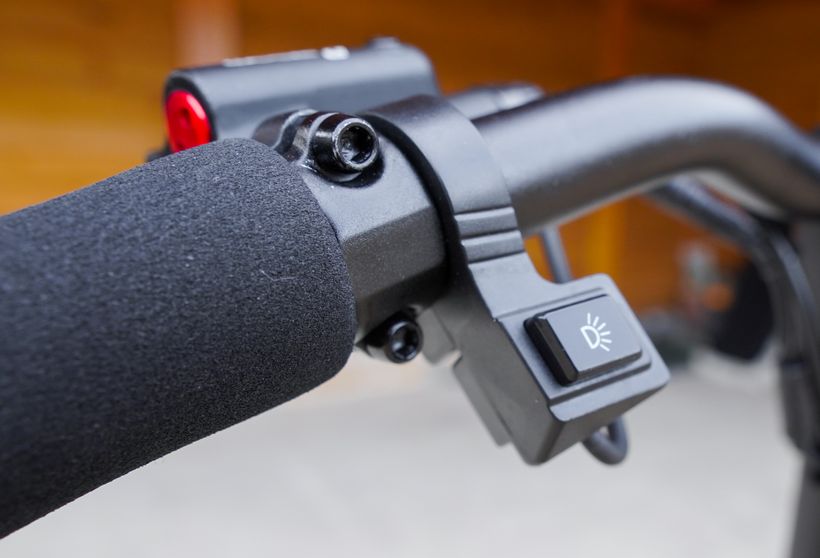
When all that’s done, it’s worth getting to grips with the QS-S4 display, and the array of P-settings it has in its locker. Double-checking your scooter’s tire pressure – and that its battery has enough juice – are also must-dos before hitting the streets. Remember, you’re best off keeping your Base inside if it’s raining – it’s not been certified to be protected against water.
Likewise, when it comes to riding at night, because the LED setup isn’t strong enough for proper visibility, you’ll need to invest in a USB rechargeable headlight that you can strap onto the handlebars.
Ride Quality
Is the Mantis Base Comfortable to Ride?
Across the board, the Mantis Base is comfortable to ride.
The front and rear springs soak up shocks protecting your joints from harsh impacts while the swingarms keep you balanced by ensuring you transition smoothly between the springs compressing and bouncing back.
The suspension system is complemented by the jumbo 10-inch pneumatic tires that are perfectly sized to not only absorb irregularities in the terrain but remain nimble and pliable, keeping the Mantis pinned to the ground where it maintains traction.
Suspension aside, the Base has the frame and build to provide a comfortable riding experience. With wide handlebars, a large kickplate, and semi-hydraulic brakes that provide very good stopping power, the Mantis isn’t just comfortable in the sense of how smooth it is to ride, but also how easy it is to control.
Performance & Safety
Speed & Acceleration
The Mantis Base is capable of reaching speeds of up to 40 mph.
But how does this stack up against similar scooters? Let’s dig deep and take a look at how it performs compared to scooters in its price and weight class.
Speed vs Price Comparison
The Mantis Base’s price bracket is certainly a popular one. When we take a $500 price range – with the Base’s $1,649 in the middle – there are a total of 19 comparable scooters. So where does the Mantis Base place?
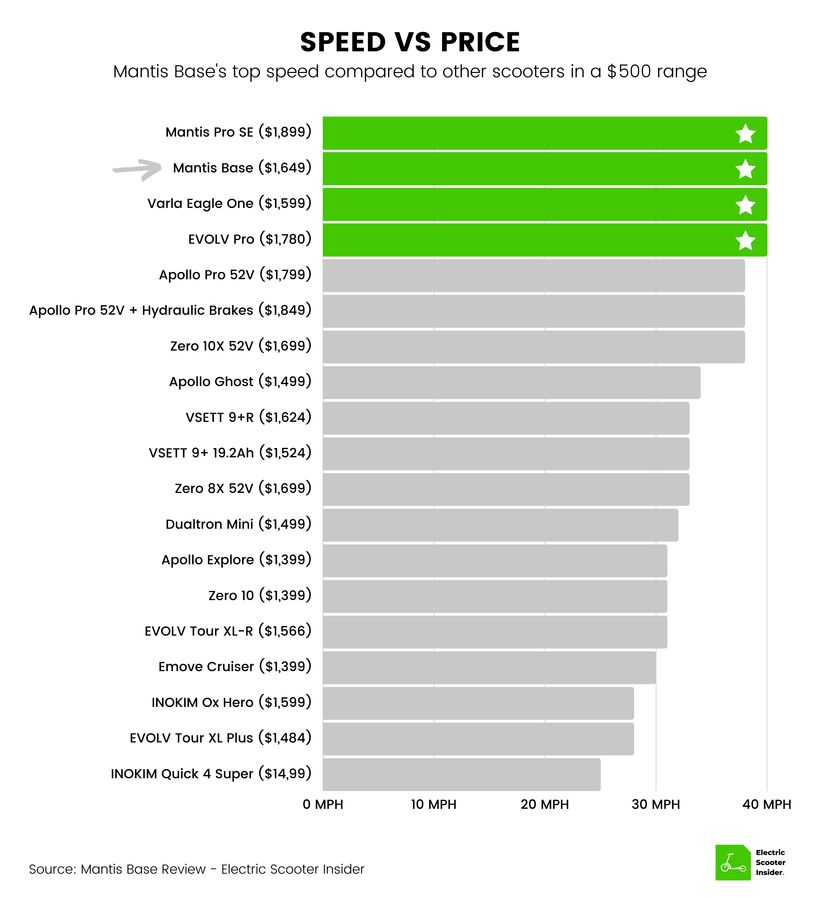
As you can see from the table, the Mantis Base acquits itself well. It shares the top spot with the EVOLV Pro, the Varla Eagle One, and its fellow Manti model, the Pro SE. Despite these four scooters sharing the podium, when we dig deeper, the Pro SE is the standout performer.
This is largely down to its blistering acceleration rate, which is a whole 20% faster than the Base. Despite all four first-place models sharing dual 1000W motors, it’s both Manti models that are capable of hitting the quickest acceleration rates. This is down to the fact that the Mantis Base and Pro SE both boast 60V motors, as opposed to the 52V sort that the Eagle One and EVOLV Pro come with.
Higher voltages mean a larger amount of power can be pulled to the motors. This increases torque and acceleration and is why the EVOLV Pro and Varla Eagle One both take around 2.8 seconds to hit 15 mph – and 6.5 seconds to hit 25 mph – while the Base can reach those speeds in 2.5 and 5.2 seconds, respectively.
Speed vs Weight Comparison
Similar to our speed vs price comparison above, the Mantis Base performs well when compared to the 7 other models in its weight class (56 to 66 lbs).
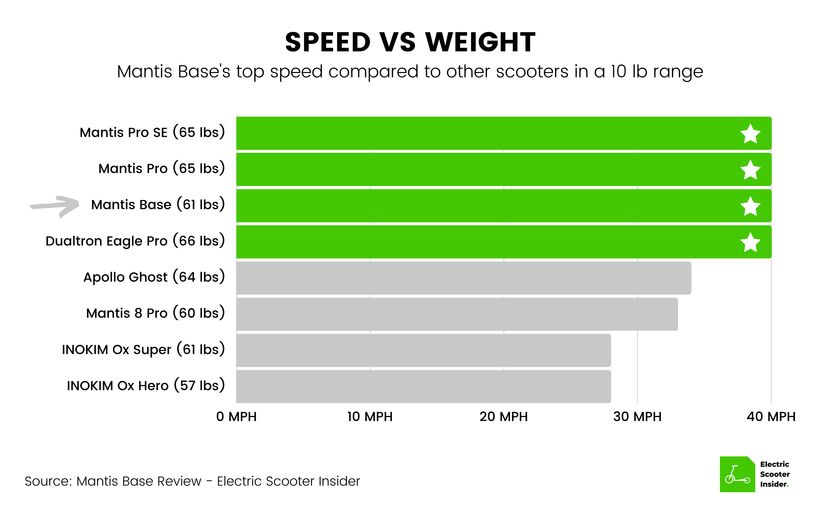
Despite weighing four pounds less than both of its big bros – the Pro and the Pro SE – the Base delivers identical amounts of top speed. However, the Base loses out, as its acceleration rate is still, on average, a considerable 20% slower than its Manti counterparts.
Weighing in at 66 lbs, the Dualtron Eagle Pro’s 40 mph top speed means it also ties for the top spot – and its very similar acceleration rate makes it difficult to choose between it and the Base. On the one hand, the Eagle Pro has a battery that delivers a 67% longer range than the base (20 extra miles, to be precise), but on the other, it suffers from stem wobble. This makes accelerating and riding at high speeds feel like you’re on a rickety rollercoaster (…not good and hence why I’ve placed the Mantis Base above the Eagle Pro in the rankings).
Acceleration
The Mantis Base is one of the fastest accelerators that money can buy – particularly when you consider how affordable it is. But how does it compare to the scooters I recommend as alternatives:
| Scooter | 0-15 MPH (Seconds) | 0-25 MPH (Seconds) |
|---|---|---|
| Mantis Pro SE ($1,899) | 2.0 | 4.1 |
| Mantis Pro ($2,299) | 2.0 | 4.1 |
| Apollo Ghost ($1,499) | 2.3 | 5.3 |
| Mantis Base ($1,649) | 2.5 | 5.2 |
As you can see, the Base lags behind the rest of the pack when it comes to reaching 15 mph. However, this shouldn’t deter you from it. The differences here – which are a matter of split seconds – are only noticeable to the battle-hardened scooter stalwarts…that is, those that have ridden a lot of scooters.
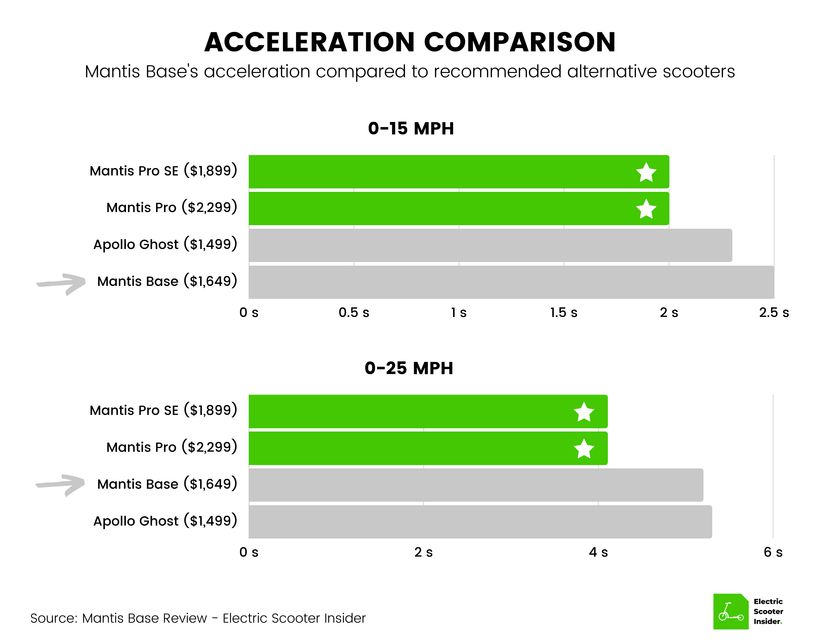
If this is your first or second scooter – or you’re upgrading from a more limited commuter scooter – then the Mantis Base still offers a sure-fire way of getting your blood (and adrenaline) pumping.
Returning to the Base’s competitors in the graph above, the Apollo Ghost is a fantastic alternative. Not only does the Apollo Ghost go toe to toe with the Base as far as acceleration is concerned, but it’s also a whole $150 cheaper. Sure – at 34 mph, it falls a little short of the Base’s 40 mph top speed. But if you take into account the Ghost’s overall performance and build quality, you get great bang for your buck.
But ultimately – if I have to crown a winner – it’s the Mantis Pro and the Pro SE that come out on top, with the SE edging the tie thanks to its upgraded build quality and cheaper price point.
Range
The Mantis Base has a manufacturer-quoted maximum range of 30 miles. To have any chance of hitting the maximum mileage you’ll have to ride in Eco mode with a single motor. With dual motors engaged and Turbo mode switched on, you can expect a range of around 20 miles.
How does this mileage stack up against the Base’s closest competition? Let’s find out.
Mileage vs Price Comparison
Unlike the speed vs price comparison, where the Base confidently dispatched 15 comparable models to place at the summit of the rankings, the scooter, this time, places last in the mileage stakes.
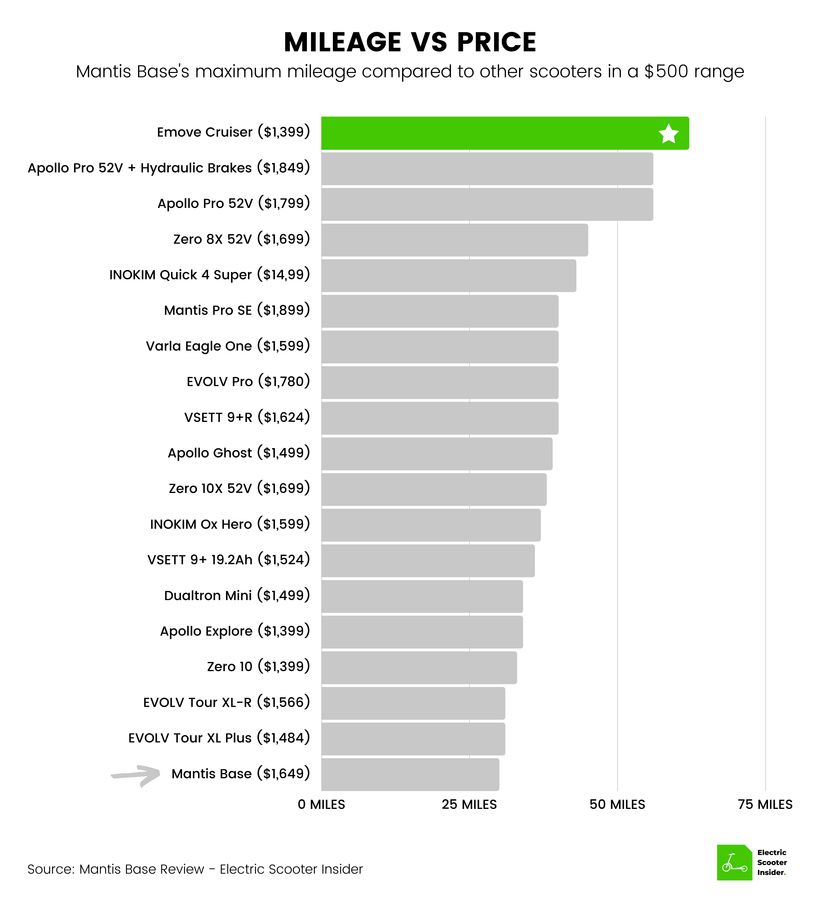
Herein lies one of the reasons the Base is so favorably priced against the other Manti models.
The Base’s 30 mile range is just two-thirds the amount you’ll get with the Pro (45 miles), and three-quarters of the maximum the Pro SE offers (40 miles). On top of this, the Base’s battery is not only smaller than its Manti counterparts but lower quality, too – it’s made of cheaper Chinese battery cells, which don’t deliver the same level of performance as the Pro and Pro SE’s LG cell-equipped varieties.
The main difference between basic Chinese and LG batteries is that the latter has been shown to deliver reliable performance without any deterioration of battery performance for up to 500 charge cycles. This equates to several years of consistent use. The same can’t be said for the cheaper Chinese batteries since they compromise performance over time. This is a key reason why the Base model is so much cheaper and something that not all other reviewers of electric scooters like to point out.
As you can see from the rankings table, the EMOVE Cruiser takes the lead. With a 62 mile range that is more than double that of the Mantis Base and a price that is at the lowest end of the scale of the $500 range, there is no better scooter to choose if mileage is your priority. However, there is one detail that may change your mind. The Cruiser only has a single 52V 1000W motor meaning it is considerably slower than the Mantis.
With this in mind, the next best long-range dual-motor model appears to be the Apollo Pro 52V (with or without hydraulic brakes). The only issue here is that the Apollo Pro models have been in short supply ever since they were discontinued and replaced with the more expensive, but greatly improved Apollo Phantom.
Similarly, the Zero 8X is also no longer in production, and – while the next best option, the INOKIM Quick 4 Super, sounds like it will be a fast long-range scooter – its single 600W motor means the scooter lacks pace. It also has no suspension to boot.
This leaves us with my top dual-motor pick in this category, the Mantis Pro SE.
Sure, there are plenty of other models that compete with the Pro SE for mileage – the Varla Eagle One, EVOLV Pro, and VSETT 9+R are all noteworthy contenders – but, when you consider the whole package, it reigns supreme.
Mileage vs Weight Comparison
Now let’s take a look at the 7 competing models in the Mantis Base’s weight class (56 to 66 lbs), to see how it measures up when it comes to mileage.
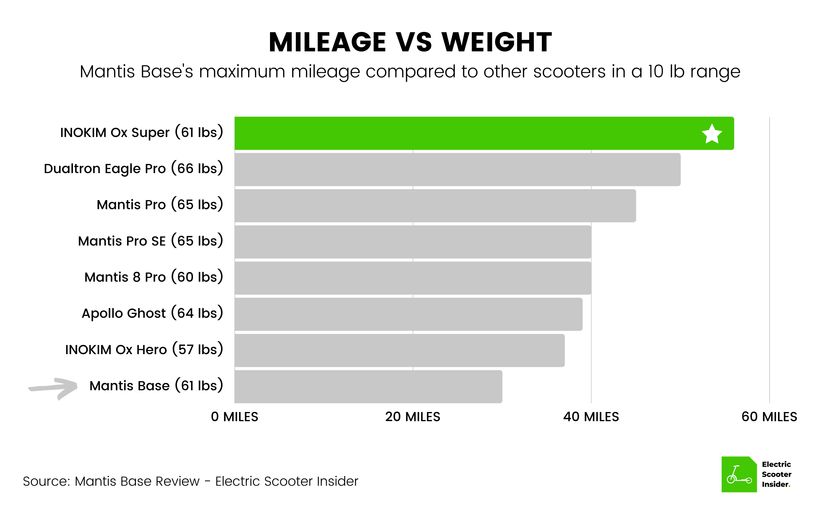
Unfortunately, it’s a similar story to our previous mileage vs price comparison. The Base falls short of all other comparable models in its weight division.
Here, it’s the INOKIM Ox Super leading the pack (56 miles), although – as with the INOKIM Quick 4 Super, discussed in the earlier Mileage vs Price section – the Ox Super lacks dual motors and suffers from a sluggish acceleration rate.
Claiming silver for range is the Dualtron Eagle Pro’s impressive 50 miles, with the 45 miles of the Mantis Pro just behind it. However, I’m inclined to award my top pick in this category to the Mantis Pro, especially when you consider the overall ride quality it offers when compared to its close Dualtron rival.
Hill Climbing
The Mantis Base is capable of cresting hills of up to 30-degrees. This is on a par with the Mantis Pro and Pro SE and is one of the best hill climbers in its price class.
Perhaps the only real aspect that separates the Base from the Pro and SE is that, due to the Base’s inferior battery, steeper hills deplete your battery more.
Electric Scooters For Climbing Hills: Breeze Up the Steepest of Inclines
Shock Absorption / Suspension
Like the Mantis Pro and Pro SE, the Base sports a dual spring swingarm suspension system. While these springs are adjustable, they offer some of the finest shock absorption with their pre-loaded stock tension and can handle both on and off-road terrain with ease.
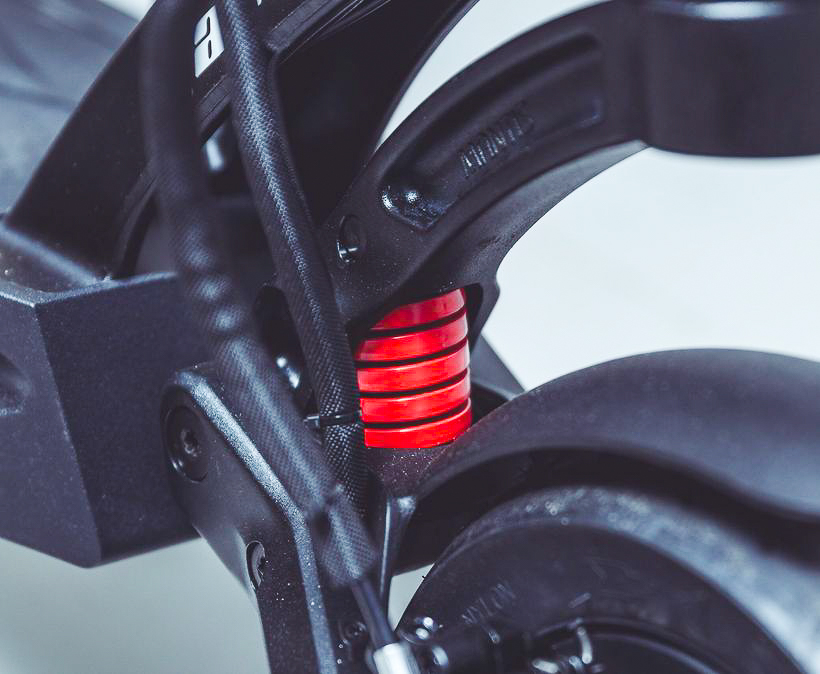
Supporting these are 10 x 2.5-inch pneumatic tires. Because these are filled with air, they are pliable and effectively soak up the vibrations and impacts of uneven surfaces.
To put the suspension of the Mantis into more perspective, I prefer it over the quadruple-spring setup of the Apollo Phantom. In my tests, I found that, despite the Mantis having fewer springs, it is better equipped to handle the rough and tumble of less even terrain without too much impact jarring your joints.
Braking
The Mantis Base comes equipped with a set of neat, cable-actuated semi-hydraulic disc brakes – and they provide great stopping power.
Compared to other scooters with hydraulic braking systems, the Base’s braking distance – 3.4 meters at a pace of 15 mph – aligns with the average. Moreover, the hydraulic braking setup belies its affordable price point. Of the 19 scooters in the Base’s price bracket ($250 on either side of its $1,649 price point), only 26% of them (or five models) have hydraulic brakes.
Despite this, the Base’s brakes fall just short of the superlative capabilities of its big brothers – both of which have full hydraulic brakes. The Mantis Pro (and Pro SE) both trump the Base’s stopping power, offering a braking distance of just 3.0 meters from 15 mph. Considering the Pro SE is available for just $250 more than the Base, the extra braking power it offers makes it a worthy contender for the additional outlay.
One other thing the Mantis Pro and Pro SE both come with is an effective anti-lock braking system (ABS). The extra security this technology provides – which stops your wheels from locking up and skidding when you brake – is worth making the upgrade for. However, an ABS isn’t for everyone; particularly because it sends a shuddering sensation through the scooter when it's activated.
The Base also has a regenerative braking system that helps extend your scooter’s battery, while also improving its stopping power. Better still, it’s easy to adjust the strength of it from the interface of the QS-S4 display. There are 5 settings to choose from, with each providing a stronger electrical braking force.
Charge Time
The Mantis Base’s 60V 17.5Ah FST battery – despite boasting a cheaper form of Chinese cells, and being less robust than its LG counterparts on the Pro and Pro SE – still has one thing going for it. Namely, its shorter charge time of between 10 and 12 hours is a full three to four hour improvement on the 13 to 16 charging duration of the Mantis Pro.
Better still, a 60V fast charger – which you can purchase through FluidFreeRide’s website for just $139 – knocks up to 50% off this waiting time, so you can be back on the road in no time at all.
Extra Features
QS-S4 Display and Throttle for Customized Performance Configuration
While it sounds like something straight out of a Star Wars film, the QS-S4 isn’t a talking robot – it’s a device that doubles as both your display screen and finger throttle.
Here’s where you’ll view your scooter’s speed, riding mode, remaining battery, and current ride time. There’s even an odometer, so you can keep tabs on the total miles you’ve clocked since you took the Mantis for its inaugural spin.
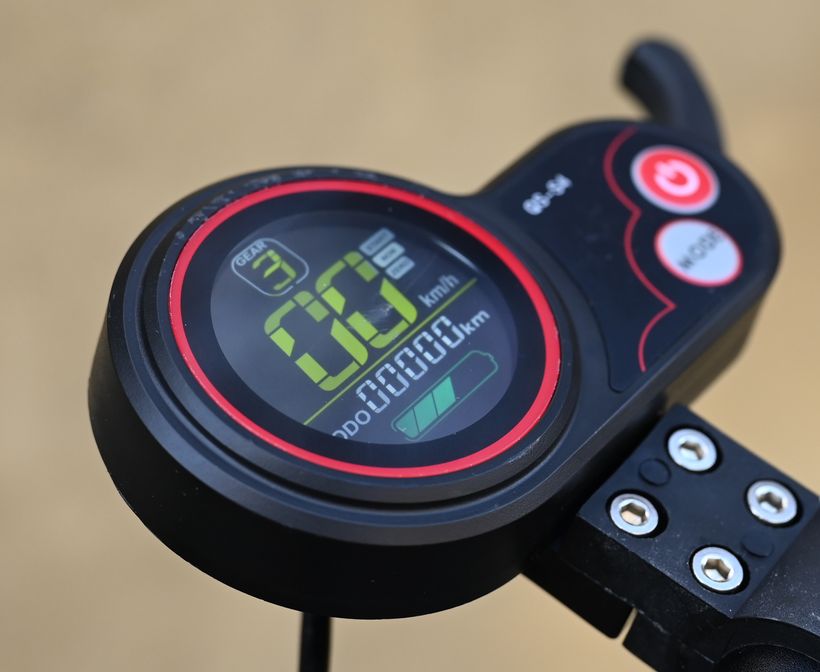
And, for an even deeper level of customization, the QS-S4 offers a range of P-settings. Tinkering with these will, among other things, allow you to activate cruise control, adjust your auto-timer off and battery-saver settings, and even set a speed limit, as well as the more technical stuff, such as altering the strength of your scooter’s acceleration and regenerative brake.
The QS-S4 also comes with a USB port, which you can, should circumstances require, use to charge your phone or GoPro. This will drain your scooter’s battery, though, and can even cause problems in terms of the overloading of the QS-S4’s circuits – so only use it if you desperately need to.
Ultimately, the QS-S4 is a feature-packed device and a great addition to the scooter. After all, it is used far and wide across the industry, and you’ll see it on models from VSETT, Zero, and Apollo.
Perhaps the only letdown is that – while the QS-S4 is a reliable, robustly-equipped finger throttle/display screen combo – it would have been nice to see the upgraded MiniMotors EY3 display on the Base. Both of the more expensive Manti models – the Pro and the Pro SE – have this upgraded console. It is far more customizable than the QS-S4.
Driving Mode & Motor System Selection Buttons
Located just below the QS-S4 console are a pair of buttons – let me break down what each of them means.
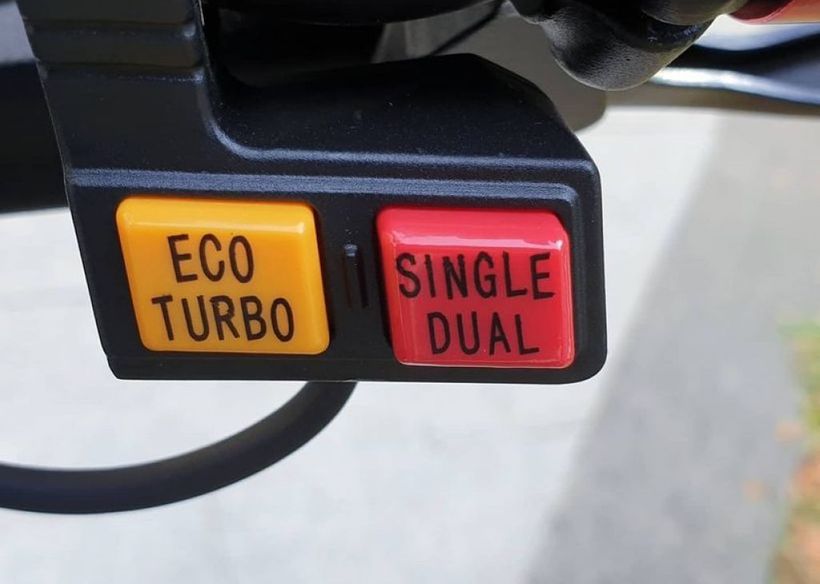
Eco/Turbo
The yellow “Eco/Turbo” button corresponds to the Base’s two riding modes.
Push this button once, and you’ll engage ‘Eco’ mode. This regulates your scooter’s power by placing a cap on the top speeds you’ll be able to hit and the amount of torque your motors will be capable of generating when you accelerate. On the plus side, Eco mode also helps conserve your battery life, enabling you to hit the dizzying heights of its 30 mile range.
Riding in Turbo mode is ideal for the thrill-seekers and adrenaline junkies, but not for those looking to make their ride last longer. In this mode, you can only hope to hit around 20 miles of range – that’s just over 66% of what the Base is capable of.
Single/Dual
Next to the “Eco/Turbo” button is a red button – labeled “Single/Dual” – which references the Base’s dual motors.
Pressing down on this button engages both motors – enabling you to harness the full power and pace and the powerful dual 60V 1000W motors. Pushing it again (so it’s not depressed) will activate the rear motor only. This, like Eco mode, caps your speed but helps your scooter go for longer.
Cruise Control
Sporting a cruise control feature, you can maintain a constant speed on longer journeys, but without having to keep the scooters’ finger throttle pulled down the whole time.
To access this feature, simply head to setting P6 on the QS-S4 display and enable it by changing the digit from ‘0’ to ‘1’. Then, simply reach the speed you want to stay at, and cruise control will kick in automatically, allowing you to keep cruising indefinitely. It disengages when you squeeze the brakes.
Mood Deck Lighting and Button Lights
Like its fellow Manti models, the Base’s lighting setup leans towards style at the expense of substance.
While the setup consists of small front and rear deck-embedded button lights and two striking strips of white LEDs that run along the platform, they are not the most practical.
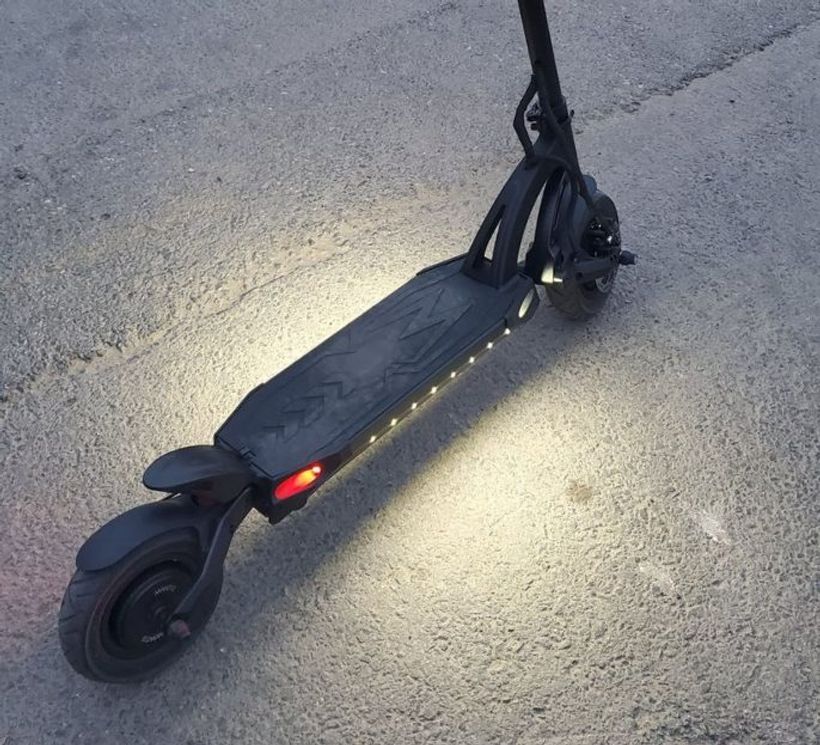
The main cause of impracticality is down to the fact that the Mantis lacks a front headlight and that the button lights are too close to the ground to offer good visibility. As a result, I can’t in good faith recommend the Base for night riding. If you need to ride after dark, strap on a rechargeable USB headlight to the handlebars.
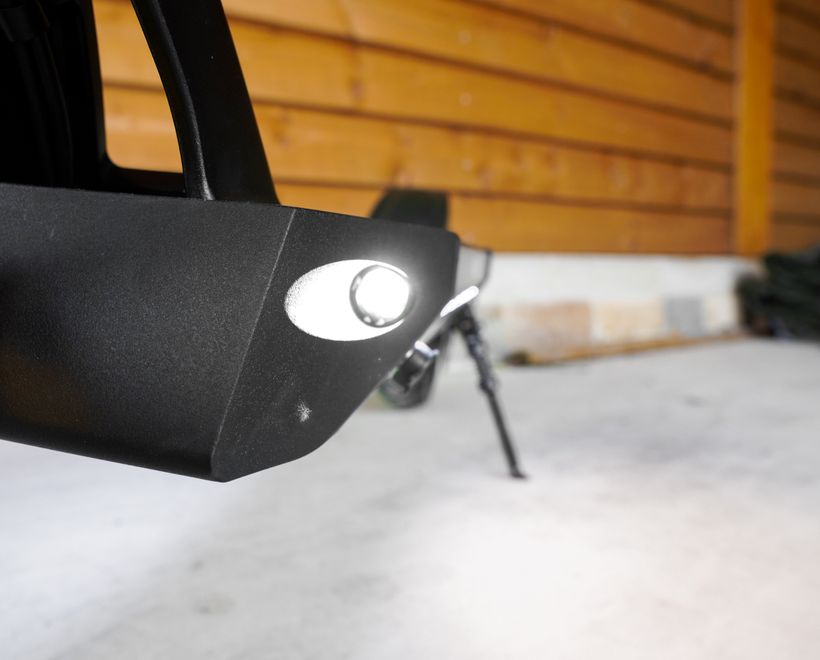
If you’re already familiar with the Manti line, you’ll have noticed that the Base’s strip of mood deck lighting (like the Pro’s) is white. The color of these lights is one of the several things Kaabo changed from the original design of the Mantis Base and Pro when it released the Pro SE. The SE’s lights are blue, so if you’re something of an aesthete, and these little visual touches mean a lot to you, you might want to consider the SE.
Specification: Mantis Review
| Brand | ||||||||||||
|---|---|---|---|---|---|---|---|---|---|---|---|---|
|
||||||||||||
| Type | ||||||||||||
|
||||||||||||
| Design | ||||||||||||
|
||||||||||||
| Performance | ||||||||||||
|
||||||||||||
| Extra Features | ||||||||||||
|
||||||||||||
Warranty & Post-Purchase Support
Warranty
The Mantis Base comes with a 6-month limited warranty, courtesy of FluidFreeRide, the scooter’s primary distributor.
FluidFreeRide promises to handle the costs of labor and will cover any problems with your Mantis Base (providing that they’re a result of manufacturing defects and not any recklessness on your part).
That said, FluidFreeRide’s warranty does come with its fair share of small print. For instance, ‘wear and tear’ isn’t covered, nor is any damage that occurs as a result of a collision, or accident. Your Base’s ‘consumables’ – that is, its tubes, tires, brake pads, etc – aren’t covered under warranty, so you’ll need to be prepared to put your hand in your own pocket to replace those parts.
Any environmental damage won’t be covered under this warranty policy, either. That includes UV exposure, sea salt abrasion, and, most importantly, water damage. Remember, the Mantis Base doesn’t have a water-resistance rating, so it’s important to keep this scooter inside when it’s wet out.
Similarly, you’ll also want to take good care of your Base when it comes to maintenance and routine care. Overloading it, misusing it, or making any misguided efforts to alter its programming, will all cancel out the warranty.
Despite all these stipulations, FluidFreeRide’s warranty is reasonable.
To submit a warranty claim for your Mantis Base, shoot an email over to support@fluidfreeride.com, along with a picture of your issue and a description of the problem.
Post-Purchase Support
Post-purchase support from FluidFreeRide is very good. They are one of few retailers that go the extra mile to assist riders with a multitude of post-purchase self-help resources. For example, Mantis has created a dedicated support hub for the Mantis, where you can find guides on how to adjust the suspension and brakes, and even replace tires and motors.
You can also get in contact with their support team on (786) 723 7323 Monday to Friday, between the hours of 9 am to 6 pm. Or, you can submit a support form via their website.
Specification: Mantis Review
| Brand | ||||||||||||
|---|---|---|---|---|---|---|---|---|---|---|---|---|
|
||||||||||||
| Type | ||||||||||||
|
||||||||||||
| Design | ||||||||||||
|
||||||||||||
| Performance | ||||||||||||
|
||||||||||||
| Extra Features | ||||||||||||
|
||||||||||||





